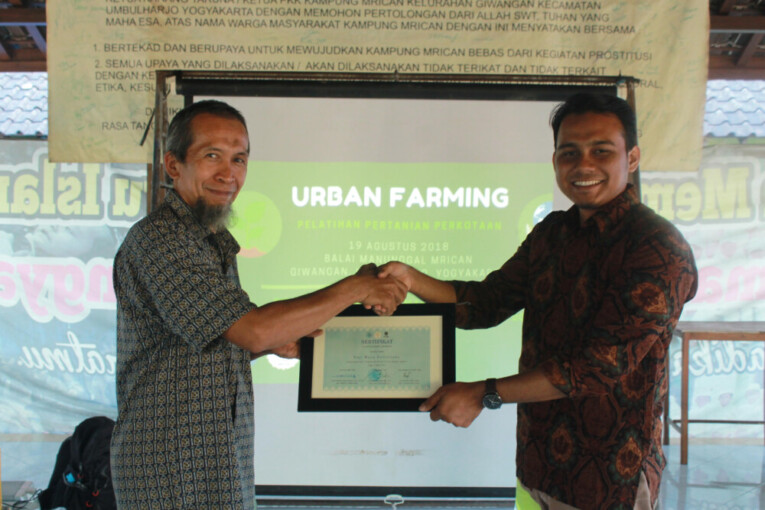
Parasitology lecturer of UGM Faculty of Veterinary Medicine, Dr. drh. R. Wisnu Nurcahyo, has been awarded by the Research, Technology, and Higher Education Ministry as the most productive writer and researcher at University level in Java. He is considered as the researcher who collaborates most and partners with foreign researchers for international publication. The award was handed by the Ministry’s Director General of Strengthening Research and Development in Jakarta, 5 July 2018.
Met in his office at Veterinary Medicine UGM on Wednesday (8/29), Wisnu expressed his appreciation for the award given by the government. To him, it was the result of his 18 years of dedication and perseverance in studying wildlife that has not been funded enough by the state. Since the 2000s, Wisnu’s research examines the behavior and parasitological diseases of orangutans. His unique research attracts foreign researchers with similar topic on the endangered animal to partner with him.
Wisnu stated his interest in studying orangutan developed from his interest in wildlife. After being accepted as lecturer in the 1990s, he attended various seminars and discussion on wildlife, where he met fellow researchers from abroad with similar interest in orangutan. He then agreed to conduct a joint research collaboration by proposing funding from foreign institutions and partners. “At first not many people were interested in this research. Even since 1992 I had to jump between trains and buses to attend every seminar in Jakarta,” he recalled.
When pursuing his doctorate in Germany in 1994-1998, Wisnu had a friend who asked him to do research collaboration on orangutan. He also partnered with researchers from Czech Republic, United States, France, and Belgium. For 18 years, he has studied orangutans and published at least 17 international journals, some of which were made into books and published by Oxford University. “All of these publications are about the life of primates, including orangutans, Makaka, and Gibbon,” said the man born in Klaten 53 years ago.
Exploring Forests
Wisnu recalled things were not easy when he first studied the life of orangutans. He had to go in and out of forests in the interior of Kalimantan and Sumatra. Along with other foreign researchers, they shared the task of observing one orangutan for each researcher.
They also did not hesitate to hire local guides, indigenous Dayak people, to find orangutans in the dense forests of Kalimantan. “They have the magical power of sensing orangutans. By burning incense, they pointed the direction that led to the animal. We took a klotok riverboat and waited at the location until we hear one.”
To identify the diseases of orangutan, they had to wait for the animal’s defecation that usually occurs in the morning. Hence, early in the morning they left to collect the faeces. “We then examined its food intake, what leaf it is. We took and correlated it with the faeces,” said the Best Young Scientist awardee from Masaryk University Brno, Czech Republic, in 2015.
According to Wisnu, leaves and fruits consumed by orangutans determined the type of parasitic disease. The leaves were then taken to the lab for identification of compounds. Results showed that many of the plants contained antiparasitic properties. “We partnered with Faculty of Forestry UGM to identify the forest plants. Then, at the Indonesian Institute of Sciences we examined the compounds.”
On the other hand, Wisnu also had an interesting experience when taking samples of orangutan in Sumatra. He witnessed an orangutan lifting a student’s backpack from a tree 1-2 meters in the air. The animal then stole a highlighter from it before throwing the bag away. “It turned out that it was attracted to the highlighter’s striking color.”
This research on behavior, types of diseases, and natural food consumed, Wisnu opined, can be applied for the rehabilitation of orangutan. Rehabilitation centers can be planted with fruits and plants having medicinal properties for orangutans when they are released back into the forest one day.
This 18 year long research collected data on behavior, diet, daily activities, and habits of orangutans in making nests. Meanwhile, the most dominant Zoonosis diseases that affect orangutans include tuberculosis, fruit bacteria such as salmonella, pathogenic E.coli, hepatitis viruses, and also viruses that have not been identified. “However, the most common parasites are malaria, worms, and diseases caused by protozoa.”
Aside from this research, Wisnu also initiated the movement of Sumatran Elephant conservation in the past three years. He partnered with elephant rehabilitation centers, trained veterinarians, and elephant handlers to improve their skills in animal health care.
His concern on orangutan and elephant conservation will persist because the population of these endangered animals is threatened by habitat destruction due to land clearing, forest fires, and poaching.
“The population of orangutan is estimated to be around 10,000 in Kalimantan and Sumatra, while there are 249 tame elephants in captive breeding centers and wild elephants of around 2,000,” Wisnu concluded.


